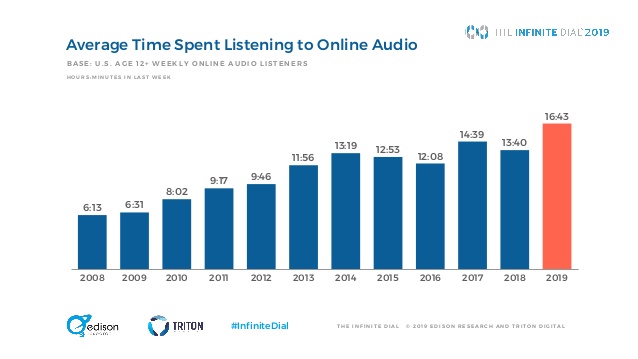In fact, in their published report, “The Infinite Dial,” the researchers state that 15 million users have stopped using the social media platform since 2017. Twitter and Pinterest usage remains unchanged, but Instagram and Snapchat have each seen a steady increase the last few years, especially with users between ages 15 and 35. However, in addition to preferring platforms other than Facebook, most users 12 and older demonstrate a growing interest in audio content. Not just podcasts, but online radio, audiobooks, and content through smart speakers too. Additionally, getting your brand into the audio content game is starting to look less like a luxury offering and more like a necessity. Spreading awareness through audio People who enjoy audio content are a part of a passionate culture that encourages brand affinity. Audio is intimate, and “tuning in” to listen to the same person muse on different topics will eventually start to feel like the host and listeners have a personal relationship. Though the majority of online users still don’t listen to podcasts, the ones who do are die-hard fans. Podcasting fits easily into a healthy content strategy because the form requires the same things successful content marketers value: trust, loyalty, and an audience that returns for more. Brands can play around with interactive smart speaker content by developing educational audio content.
In a new study on content formats, Edison Research found that interest in Facebook content is still in steady decline. In fact, in their published report, “The Infinite Dial,” the researchers state that 15 million users have stopped using the social media platform since 2017. Perhaps less surprisingly, the drop-off in usage is most obvious with people under age 55. Far and away, Facebook remains the most often used platform, but it’s not necessarily growing.
So what is everyone younger than 55 doing online instead? Twitter and Pinterest usage remains unchanged, but Instagram and Snapchat have each seen a steady increase the last few years, especially with users between ages 15 and 35. That all tracks with the common understanding of young people and their online habits—they’re more comfortable with ephemeral content and multimedia, and they’re way more likely to share content they enjoy.

However, in addition to preferring platforms other than Facebook, most users 12 and older demonstrate a growing interest in audio content. Not just podcasts, but online radio, audiobooks, and content through smart speakers too. In fact, time spent listening to any kind of online audio content is at a record high. On average, people take in 17 hours of it per week, and the researchers describe “an estimated 14 million new humans [having made] podcasts a weekly habit” in the last year.
All this data says a few choice things about content preferences. As we move toward the 2020s, brands and publishers need to seriously consider adjusting their strategies if they’re too reliant on a Facebook audience. Additionally, getting your brand into the audio content game is starting to look less like a luxury offering and more like a necessity. A disparate range of brands have already gotten started, including Barneys New…

COMMENTS